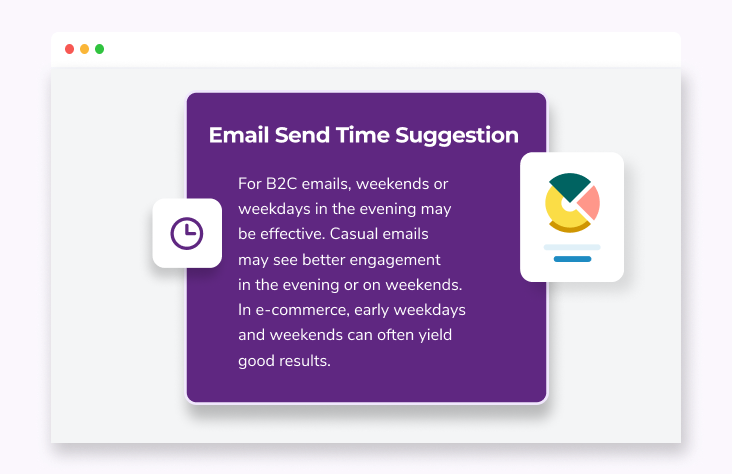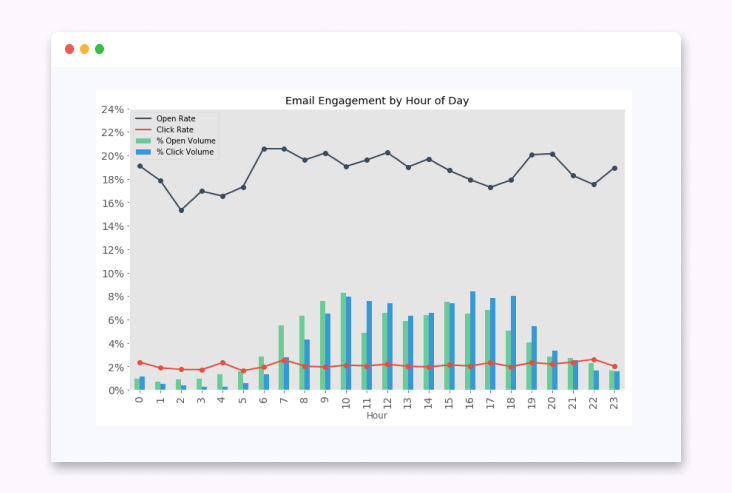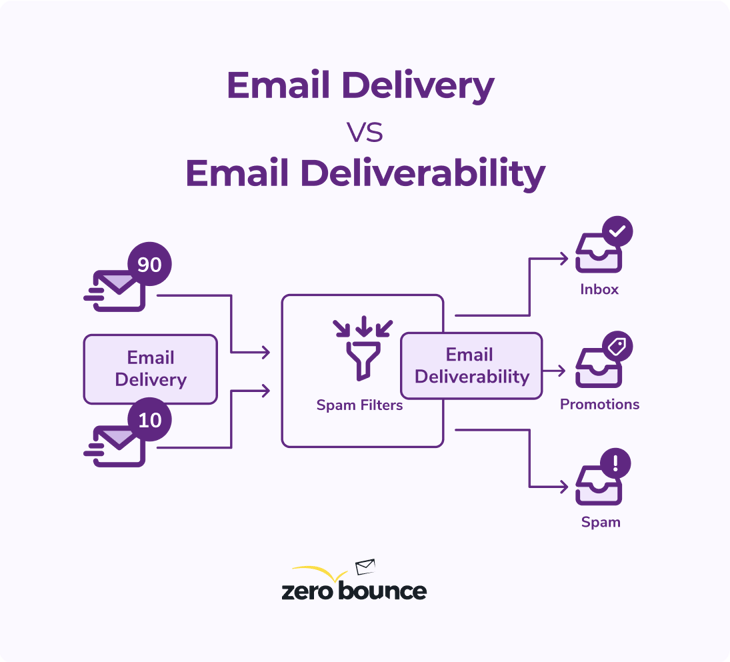Email Send Time Suggestion Tool
What’s the best time to send an email? The answer eludes even some of the best email content creators.
Take advantage of our email send time suggestion tool to discover optimal email send times to help improve email open rates and maximize email engagement.
Try it now —>
Email Send Time Suggestion
Who is your audience?
What is the nature of your email content?
What is your industry?


Using the email timing tool
Our email send time suggestion tool is a quick three-question survey that helps us understand your brand and email content. These questions focus on three critical factors:
- Who are you emailing? (professionals or consumers)
- The type of content (is it “fun” or all about business)
- Your brand industry and what you’re marketing
Your answer to each adds significant variance to optimal email send times. Once you provide your responses, we will compare them to the most recent statistical data regarding 16 unique industries. We’ll help you learn which email scheduling strategies work well for similar players in your industry.
Understanding your email send time suggestion

After completing the questionnaire, you’ll receive several email send time suggestions.
Our example responses show that evenings and weekends are optimal send times for an e-commerce brand catering to a B2C (buyer-to-customer) audience. As in our example, it is typical to expect variance depending on your unique situation.
You can test two or more email scheduling strategies for a set duration and adjust them based on your results.
What’s the best time to send an email?
The best time to send email blasts depends on your industry and how your audience responds. That said, weekdays generate the best results when averaging performance across all industries.
Tuesday through Thursday are unquestionably peak days for helping you improve email open rates.
See our best email send time suggestions from brands like Mailchimp, Hubspot, and Experian.For the exact time of day, the same studies suggest that the week mornings are excellent for email engagement, with 11 AM showing strong opens and clicks. Activity dips noticeably during lunch breaks and returning to work before rising again toward the end of the workday.

Peak email opens at 10 AM, and peak clicks at 4 PM - Source: Brevo
At a glance, this data makes sense. According to our Inbox Email Statistics Report for 2025, 80% of correspondents said they must check their email for essential work messages. A bit less than 50% of correspondents also said they seek promotions or messages from close acquaintances.
With that in mind, it’s fair to assume most audiences begin their day by checking their devices and reviewing the day’s tasks before beginning work at a typical 9-5, making it a great time to get eyes on your email.
However, the morning isn’t the end-all-be-all for your email campaigns. Most correspondents check their inboxes more than once, with the peak up to five times daily. Based on this data, many subscribers check their inboxes and open emails, with even more clicking through to content as the workday ends.
Check out the full report for more information that can help your email campaign optimizationⓘThe act of improving critical areas of an email campaign, including identifying the ideal audience, improving email content, and email deliverability to yield improved engagement via open rates, clickthrough rates, and conversions.
Read the reportIndustry impacts audience engagement strategies
Removing ourselves from email marketing as a whole, your industry may deviate from typical optimal email send times.
For example, professional emails, particularly in the B2B, tend to perform best at the beginning of the week as professionals look to attack the week ahead of them. Conversely, Friday performs worse as workers wrap up critical loose ends and look toward the weekend.
E-commerce, on the other hand, works well on Tuesdays, avoiding competition with high-priority professional emails. Shoppers are likely to engage and buy early in the week to avoid those pesky shipping delays that come with the weekend.
The benefit of proper email timing
Improve email open rates and clicks
Finding the best time to send an email can help maximize email engagement.
Open and click-to-open rates are key email marketing metrics that directly communicate how well your email marketing performs. It’s also essential for determining if your audience is actually receiving your email content.
Excellent email copy and subject lines can get buried by sending at the wrong time. If you send an email too late on a Friday, the subscriber’s inbox has the whole weekend and Monday morning to make your old content irrelevant.
Timing in email marketing is vital. Figure out when your customers check their emails and deliver your content when they’re most likely to engage.
Curious about your open rate performance? Try our free, ungated performance calculator
Calculate your open rateEmail deliverabilityⓘA sender’s ability to reach the recipient’s inbox with their outgoing emails. It may also describe the ratio of emails delivered to the inbox vs. those sent to spam or blocked by the receiving server. optimization
Cleaning up your audience engagement strategies is also crucial for email deliverability optimizationⓘThe act of diagnosing and improving email list health and domain reputation factors that determine the likelihood that an email message will reach the inbox..
By email deliverability, we refer to the emails that land in a subscriber’s inbox. This differs from “delivery,” as some of your email content may also end up in the spam folder.

Low email engagement hurts your deliverability. If you’re not using optimal email send times, your audience won’t open or click, and your future emails will struggle to reach the inbox.
Superior email marketing ROI
Finally, determining the best time to send marketing emails is essential for better ROI.
Consider this - users subscribe to your email list because they like your brand. They want to engage with your content - you just need to provide it. But those conversions only come when you try to reach your audience on their terms.
If you’ve got an excellent promo that can benefit a reader, find the best time to send that email. If it’s convenient for the reader, they’ll make the time to click and interact. If you pick the wrong time, you’re likely to be forgotten.
Find the best time to send marketing emails
The truth is - there’s no universal best time to send an email. Studies from the top email service providers and marketing brands show varying results. That’s because email scheduling strategies provide different results for different audiences.
The email send time suggestion tool will help you optimize email send time based on similar peer results. Afterward, you should conduct rigorous testing to get a clearer vision of your brand’s unique audience persona.
After all - the best time to send emails is the time that gets engagement. If your email open and click rates jump on Saturday afternoon, let that be your ideal email timing.
Frequently asked questions about email timing
The best time to send an email is whichever period attracts the most email engagement from your audience. When comparing all industries, sending email content on weekdays between 6 AM and 4 PM is statistically best. However, your industry and unique audience persona are also critical factors. It’s best practice to experiment with and optimize email send time based on your campaign performance.
You can improve your email open rates by researching and testing optimal email send times for your audience. Additionally, be sure to use clear, compelling subject lines that let the reader know what your email contains and what they stand to gain from opening it.
Improving your email engagement depends on various factors, including email timing, the quality of your subject line, the length and layout of the email, and a compelling call to action. You should regularly experiment with audience engagement strategies and track your performance metrics to determine which email marketing strategies work best with your email list.
There are no restrictions on how early you can send an email. However, if you want to improve email open rates, stick to research-backed send times no earlier than 6 AM. At this time, early risers will look to start their day, including checking their computers, mobile devices, and email inboxes.
You can send emails at any time. However, emailing someone too late in the day is unlikely to earn engagement. For many email readers, 4 p.m. is the peak for email opens and clicks. However, some individuals may give their inboxes a final check in their free evening hours well past 8 p.m. Experiment with your email campaigns to determine when your engagement declines.